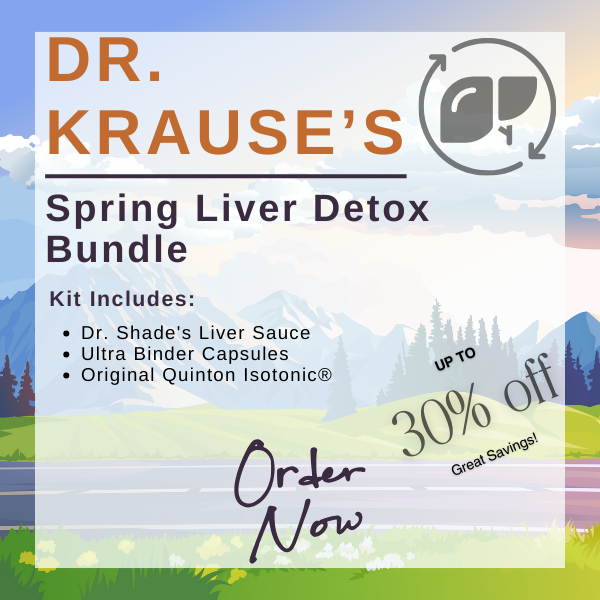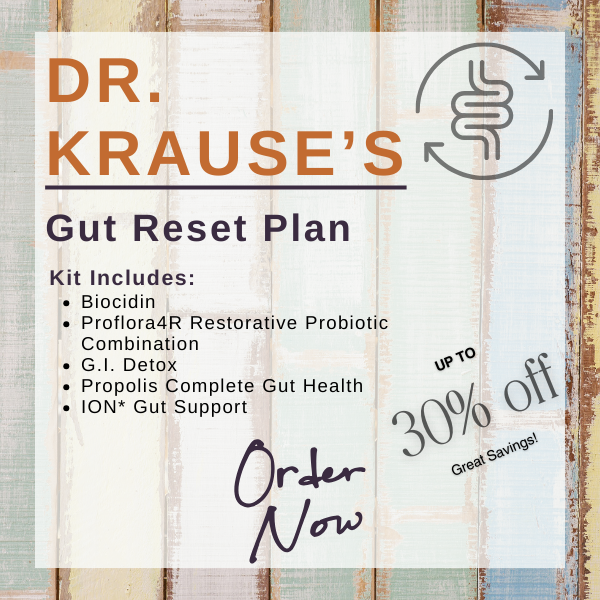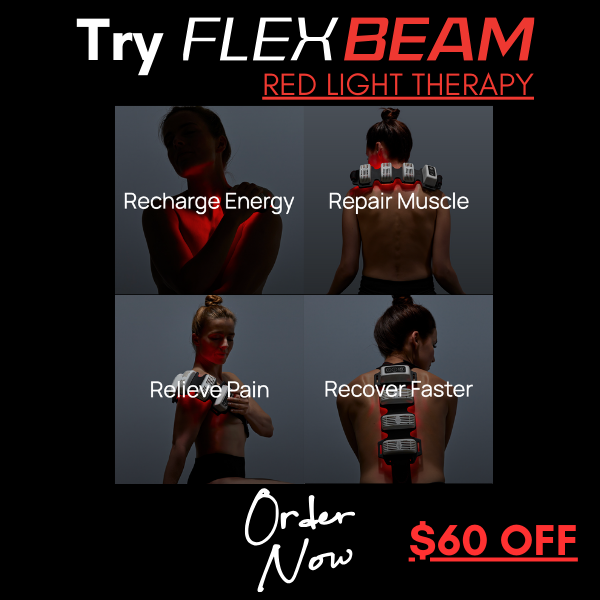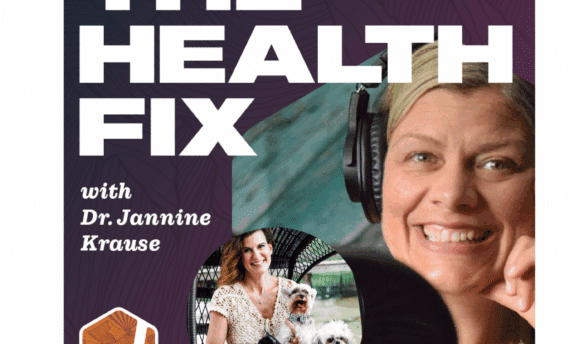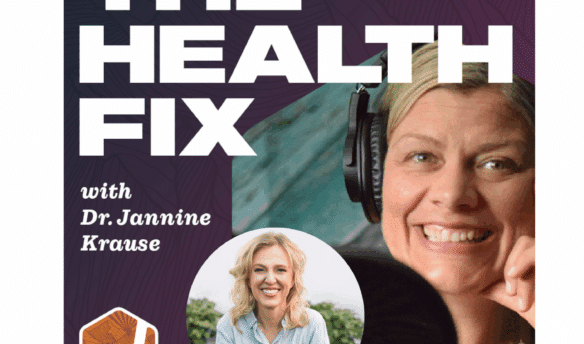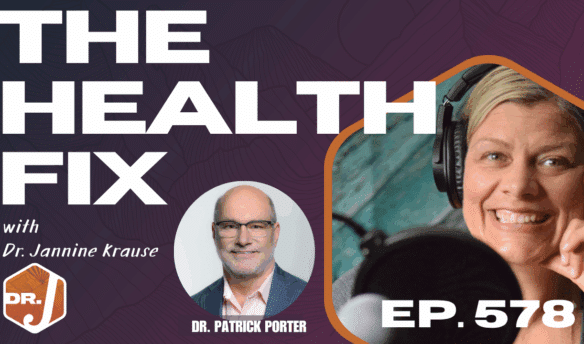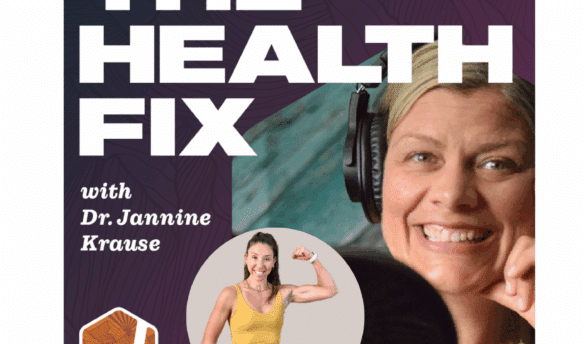Is it possible to use your mind to help relieve pain and illness? Do energy and emotions really impact your health? Brandy Gillmore is an author and inspirational speaker who went from being disabled and spending most of her days in bed to walking about and sharing her story of recovery. Brandy blew her doctors’ minds with her success and is on a mission to share how combining emotions, energy and mindset work relieve pain and help resolve chronic illness. She’s sharing and demonstrating clients stories of pain and inflammation relief using medical thermal imaging as she too was once a skeptic! In this episode of The Health Fix Podcast, Dr. Jannine Krause interviews Brandy Gilmore on the power of the mind to relieve pain and end chronic illness.
Dr. Krause’s Protocols
Instructions Included
Traveling soon? Looking to detox or reset your gut? Try one of Dr. Krause’s Fullscript plans.
What You’ll Learn In This Episode:
- Using thermal imaging to show real time pain relief happening in the body
- Why belief isn’t required to get results when using your mind to relieve pain
- How specific mis-wired emotions need addressing to allow the body to heal
- Why self love and image are deeply tied into chronic pain and illness
- Connection of mindset and wiring of the mind to releasing pain and illness.
- An insider look into Brandy’s Book and GIFT method.
Resources From The Show:
Brandy’s Book – “Master Your Mind and Energy to Heal Your Body – You Can Be Your Own Cure”
Our Partners
Podcast Transcript
7:29 – Brandy’s story
10:53 – Some medical thermal imaging images
14:44 – How the mind affects the body
22:10 – How Brandy healed herself after her accident
25:37 – Identifying as sick
30:07 – The GIFT method
32:12 – Brandy’s book, “Master Your Mind and Energy to Heal Your Body – You Can Be Your Own Cure”
37:19 – Connection between emotions and pain
42:50 – How to connect with Brandy
[Intro] Welcome to the Health Fix Podcast, where health junkies get their weekly
fix of tips, tools, and techniques to have limitless energy, sharp minds, and fit
physiques for life.
Hey Health Junkies! On this episode of the Health Fix Podcast, I’m interviewing
Brandy Gillmore, she’s an author and a public speaker who is helping to educate
folks on how their own bodies can be their own cure, especially when it comes to
to chronic illness and pain. After an unexpected event, Brandy found herself disabled and desperately
searching for answers. In fact, she ended up going from being bedridden to a wheelchair
to a walker to walking. And now she’s helping folks understand how their mind and energy
can help them to relieve pain and work with chronic illness. So, I’m excited to introduce
to Brandy, we talk a lot about emotions, we talk a lot about how different things in our life can
be reframed to help us to relieve pain. But we’re also talking about something really cool,
how she is using medical thermal imaging to show how she is in real time helping folks relieve
their pain. So if you’ve ever seen thermal imaging such as heat in the body, she is showing how that
reduces while she works with folks to work on their thought process and use their mind
to help relieve pain and inflammation in the body.
Very cool stuff and especially if you’re like, Hmm, I don’t know.
This stuff’s kind of woo
Check this podcast out.
And if you have access to YouTube, you can see the video showing inflammation and then
reduced inflammation after she works with someone.
Really cool stuff.
Let’s introduce you to Brandy Gillmore.
JANNINE: Hey, health junkies.
I’m Brandy Gillmore on today and I’m excited to talk about how you can heal yourself.
It’s a topic that we’re starting to get more traction on back in the day when, you know,
I was talking to folks about it.
I get that deer in the headlights look, but Brandi has some technology that can show you
really what’s happening in real time.
So so cool.
We’re going to get into that.
So Brandi, welcome to the health fix podcast.
BRANDY: Thank you, Jannine.
It’s so wonderful to be here.
And I love that you said that the deer in the headlights look, I absolutely get it.
Literally after I healed myself, I thought people are going to think this is impossible
or how does this does this even work?
And so I love that you said that.
JANNINE: It’s it’s a common look that I get even nowadays.
I do acupuncture.
I do a lot of, you know, coaching folks on healing themselves, mantras, tapping, you
know, you name it.
And a lot of times when people are like, they’re like, Hmm, I’m going, what are you thinking
right now?
Tell me what you’re thinking.
Because there’s always that look.
BRANDY: You know, that is, that was, it’s so funny that, that was exactly what I figured that,
you know, just, I would experience, I thought, okay, so after I healed myself, I thought,
you know, from wheelchair walker, cane being an absolute mess, I thought people are going
to think this is impossible.
I mean, I was a train wreck and I would have thought this is ridiculous.
I would have never thought that it was possible to, to heal with my mind.
In fact, if somebody told me I could heal with my mind, I probably would have been offended.
Like you think my problem is all in my head.
And so.
JANNINE: Right.
And as a doc, like it is that slippery slope where you’re like, I really think this could
benefit you.
I don’t want you to think.
I feel like I dance around sometimes.
I’m like, I don’t want you to think that I think it’s on your head because, I mean, it
isn’t a way, but I’m not saying, you know, it’s like, oh–
BRANDY: This is how I describe it though,
is actually, and it’s not all in the head.
So the things that I’ve seen are on very physical levels, but the way I describe it,
kind of just an analogy, is to think about an emotional stroke.
If you think about a stroke, somebody can have a stroke in their brain and it can paralyze
their body.
So we can see there’s a brain body connection.
And so when we start to look at it, anything that does happen in our brain can very much
affect our physical body.
And so, you know, if you have a right brain stroke, it can affect the left side, the left
brain stroke can affect the right side.
And so I started thinking about, okay, well, what if this is like an emotional stroke,
if you will, like emotions impacting the brain that are then in turn affecting the corresponding
part of the body.
And, you know, something that was interesting even in that research and not to get too technical,
But if you think about the homunculus map where neuroscientists were able to, brilliant, brilliant
data where they were able to stimulate different parts of the brain and then notice where it
showed up in the body.
So they could stimulate like the insular cortex and then it would make somebody feel like they’re
going to vomit.
And so it’s so different parts of the brain do impact different parts of the body.
And so, and also when we look at emotions,
research has shown that emotions can make a very physical
impact even on the brain, you know,
things like PTSD or stress from a car accident
can even actually change the shape of the brain.
So anyways, what point being is just
our emotions can create a mindset,
can create a very real impact on our physical body.
JANNINE: It’s so incredible.
You know, first I grew up in the Midwest.
I always, I’m sound like probably a broken record
to my podcast listeners, but I grew up in the Midwest,
you know, it’s one of those things where like,
you know, even becoming an acupuncturist
was a stretch, right?
And so thinking like, okay, my emotions
can get stored in my body.
They can create different things.
It’s crazy, but yet at the same time,
we’re all like, do you have stomach, you know,
butterflies in your stomach?
Are you nervous?
And it’s like, we get that.
Why can’t we, why can’t we go to the next level?
BRANDY: Exactly.
And so a few things.
So when I got better, I thought, okay,
I have to show this under medical equipment.
That was like, that was my goal.
I said, you know, I just have to show people so it works.
And technically what I did is after I healed,
I thought, you know, let me show people.
And the first thing that came to mind
was showing people how to release pain.
JANNINE: Yeah.
BRANDY: And so I would show them how to use their mind
and they would be able to release their pain.
And it was incredible.
And there was this one time when I was on stage.
And normally on stage, I’d take volunteers
from the audience and show them how to use their mind
to release their pain.
And as I was getting off stage one time,
I thought, you know, one of these times,
somebody’s gonna say, that person was fake.
They didn’t really have neck pain or back pain or whatever.
And that would have been me previously
’cause I was, this is impossible.
And so that’s what really drove me to start
even figuring out how to do it under medical equipment
to show that it’s not mind over matter.
it’s not pretending like there are real physiological changes taking place.
JANNINE: And I think that is genius because this is where I’ve been able to really have a talking
point to folks to be like, look, there’s this, you know, Joe, this man’s has got a
functional MRIs, you know, we’ve got lots of different things to show folks.
What, you know, I see that you have a background as a network engineer.
So I’m guessing you were thinking technology right out the gates like, what could I do?
What could I do?
who turns you on to medical thermal imaging,
or did you find it yourself?
What brought you to it?
BRANDY: You know, actually, when I started,
when after I got better,
I started actually working with this chiropractor
and I was helping people in his office and whatnot.
And at the end of me getting better,
when I was, basically I had a scan taken of my back
And you could, I mean, the whole thing was like red and white.
It was, it was, it was a mess.
It was, oh, and so, and that was, you know, gosh,
I mean, my injury was 21 years ago now.
So, I mean, it was, so, but I had that done.
And I didn’t even think about it again until years later when I said, you know what?
I wonder if this would work because I didn’t know.
And part of the reason I didn’t know if it would work is that
Medical thermal imaging, what it does is it checks the heat of the body.
And a simple way to think about that is, you know,
if somebody has a sprained ankle or an infection, you know, it generates heat,
as you know, and medical thermal imaging is able to detect this heat.
And what I didn’t know at the time is, okay, well,
if I show somebody how to release their pain,
how soon is that going to affect the heat temperatures of the body?
Like, is it gonna be like a one hour response time to,
okay, well, their pain is gone,
delay, delay, delay, delay, delay, delay, delay,
oh look, now you can see it on the scan
because I didn’t want that.
I wanted real time results because, you know,
when you think about it, let’s say neck pain,
somebody can always say, well, I turned wrong
or I worked out or, you know,
and so I wanted real time results.
And so that’s, and so basically what I did was this,
is I reached out to Dr. Hilary Smith,
who’s advanced medical thermography,
and basically asked her to start scanning people
while I worked with them using the mind.
And what was brilliant is that she set
the thermal imaging camera up to take a new image
every one second.
JANNINE: Oh, wow.
BRANDY: Automatic, right?
Every one second.
So it’s just, and then what would happen
is then I worked with people
and you could literally see as their pain went down,
it also changed. Now what was also great is that if I then mentioned and went that had
them go back into the negative mindset, then the pain would come back up and you could
see it instantaneously. And while obviously pain not coming up as is great, the wonderful
thing is you could see it’s not placebo analgesia. You can see it’s not just mind over matter.
Like it’s in real time. None of this was even told to them. And so that’s what’s fun
as you can see it.
JANNINE: I love that. Being a doc that looks at a lot of breast thermography,
there is an image where we can see their nagging. How many people have inflammation in general
in their back or along their spines? When I saw that you were doing that, I was like,
“Oh, wow. How cool to be able to be like, look, you’ve got this on your thermography. Let’s move
you over to see Brandy and see if we can get rid of that pain that you’ve been having forever.”
BRANDY: You know, and actually, by the way, I don’t know if I can do a share screen, but if so, I can show you what this looks like.
I think so. Let’s see if you actually can.
JANNINE: Okay, perfect.
BRANDY: All right.
Does that work?
JANNINE: Yes.
Let’s do it.
Yeah.
BRANDY: So let’s do it.
So this is actually, I’m just going to grab a medical.
I had, I got these published in a medical journal, a few case studies last year.
And, um, okay.
So if we go grab this right here and basically what these are.
So I mentioned, you know, the heat and we’ll see, let’s see, it takes a second just for the images to show up.
Sometimes there we go. All right. So this is an image of a woman.
This is 22 minutes apart and she had a 5.5 level of pain.
And as you can see, this is all of the pain, the inflammation, and this is 22 minutes later.
And so, and I do want to emphasize, I make this look really, really, really easy.
Now, this one is 47 minutes.
And this one is fun because what’s fun about this is that this gentleman, after I worked with him,
and it was 28 minutes, and his pain went from a six to a zero.
And after I worked with him, he said, wow, I’m surprised at that work.
I just came from a motivational seminar and a 10 day meditation retreat.
JANNINE: Holy
cow!
holy
cow!
BRANDY: Which was great. I didn’t know going into that that he had just done that, but it’s so it’s
specific things in the mind. And I always,
always want to emphasize I make this look ridiculously easy.
And so it does take an understanding of the mind.
And of course we can unpack that even more, but, um,
But I just want to emphasize the average person isn’t probably going to be able to release their own pain in 28 minutes or 20 until you know how to do it once.
That’s what’s exciting.
This is what I love.
JANNINE: Absolutely.
BRANDY: People do after they heal themselves, they go, oh my gosh, I just released my headaches or I just got rid of my pain or it becomes a thing that you start to learn.
It’s a skill.
So so.
But yeah.
JANNINE: I think it’s awesome.
It’s, you know, this day and age having these skills where we can turn to ourself and not have to get medication, not have to go, you know, I’m not saying don’t see doctors, but I’m saying that so you don’t have to figure out how to get to the ER at three in the morning when pain sets in.
You can neutralize it yourself.
I mean, this is this is huge.
So of course, folks are going to be like, Brandy, what are you doing?
What are you teaching people?
What’s happening?
BRANDY: Right.
JANNINE: But about your book too, but let’s yeah, give us a scoop.
BRANDY: Absolutely.
And by the way, what I always tell people to do is I always say, don’t avoid your doctors,
blow your doctor’s mind with what you’re capable of with your mind. And that’s kind of like the
theme because, you know, it’s just, we want to be responsible with it. And it’s also just incredible.
And I even, I had a woman that I worked with who had a tumor in her throat. And she was scheduled
for surgery the next day. And she had just had a pre-op MRI. They measured the tumor again.
It was five millimeters.
You could see it protruding.
And so they had measured it, you know, scanned it several times, day before the surgery,
her and I worked.
And after we did it disappeared.
And she showed up for, she, so she didn’t avoid her doctor.
She still showed up, showed up for surgery the next day.
And her ENT was like, I’ve never seen this anything like this in my 30 years of practice.
And this is incredible.
So point, just point, just always see your doctors,
blow their mind with what you’re capable of.
And so just, yeah, love that.
JANNINE: I want people to do that for me.
Like comment and blow my mind.
I wanna see this.
Like guys, let’s do this, let’s do this.
So tell us, like, what are you up to?
What kind of things are you teaching folks?
How do you get started?
Give us kind of a good idea.
Good look into what you’re up to.
BRANDY: Absolutely.
So ultimately what I would love is that every single person
feels empowered to be able to understand their mind, body
connection, and heal themselves. You know, when you stop and
think about it, it’s been written throughout history in every
spiritual practice pretty much in one way or another. I mean,
it’s even in the Bible where it says a merry heart is a
medicine to the body. ill thoughts will dry the bones, stress
affects the body and placebo, no, SIBO. I mean, we can see it in
in so many ways how the mind impacts the body.
And so what I’m up to is that’s ultimately
what I would love is everybody to be able to do it themselves.
And basically to start what a person would do is,
ultimately I think the first thing is really understanding
that we can.
JANNINE: Yeah, yeah.
And believing, ’cause I think there is a level
of believing that you have the power.
If someone’s not in belief, I kind of wondered,
have you noticed like you can get some results
even if someone’s not 100% bought in?
BRANDY: Actually, my thing has always been
when I take somebody who is skeptical and I said,
okay, let’s do it.
(laughs)
JANNINE: Nice.
BRANDY: That’s been mine.
‘Cause I like to show people, I love to blow people’s mind.
And so this is what I would say is a few things.
Is if somebody has panic attacks,
If they are having anxiety and they start having panic attacks, that’s going to happen
whether they believe it or not.
That can happen.
Another way to look at it is, as I was researching and trying to figure out how the mind affected
the physical body, there were a few really key insights that were pivotal.
One was that people with multiple personality disorder can have different ailments when
they’re in different personalities.
They can have high blood pressure in one and regular in another.
They can have asthma, allergies.
They can be extremely allergic to something in one personality and not in another.
There’s even a well-known case of a woman who was blind, medically blind in some personalities,
but not in others.
And yeah, and things like body temperature, heart rate, all of these things that you wouldn’t
think, “Oh, I’m going to change my body temperature.
I’m going to change my heart.”
And so, you know, and so or asthma, all of the and they happen, they can happen instantly
when some when a person shifts.
And that was something that was really eye opening to me.
Another thing that was really eye opening is I initially thought when I started researching
mind body healing, I thought of the placebo.
And a lot of people would say, well, it works because of belief.
You know, the belief it’s going to work.
And so I like forced myself to believe I was already healed for a long time, like well
over a year, if not longer, you know, at lost track of time during my home injury, but I
was forcing myself and affirmations and chanting and I mean all these things that I would have
never done previously, but I was doing it.
I was I was I was all in and it wasn’t working.
And so as I started researching, I eventually came across something called the open label
placebo. It is exactly like it sounds. Open label, both the doctor and the patient both
know it’s a fake pill and it can still work.
JANNINE: Hmm.
BRANDY: So–
JANNINE: Wow.
BRANDY: Then I started realizing, well,
hey, this isn’t all about leaf. So, but I would say that, of course, the more we understand
how to use it. The more we can implement it. And by the way,
another kind of factor that we can look at when it comes to
belief is this. I know me during my injury, I could have
really good days, like better days, and I could have really bad
days. And that didn’t happen because I believe that was before
I even started looking at the mind. I know people with all
kinds of illnesses, rheumatoid arthritis or, you know,
autoimmune conditions, pain, broken leg, this, that, you can have good days, you can have flare-ups,
you have bad days. And so it’s not because you believe it’s going to happen, it just, you wake
up and that’s how you’re feeling or off. And so as we can see, with the same physical issue,
we can have a lot of different changes going on. So I would say again, just pointing to the
awareness that there’s a lot more than, than belief that, and belief is a good thing in that,
when we do believe we can do something, then we know we can, then we’ll put more effort towards
doing it. And I think that’s of course pivotal.
JANNINE: Sure, sure. I think, you know, we kind of get a
fuel in the fire, right? Once we see a little progress, we see a little more progress. Now it’s
like, okay, okay, you know, what more can I do? I’m sure you experienced that along the way when
you’re like, wow, okay, I’m feeling better. Oh, I can do. Oh, and you just kind of had a drive,
I’m guessing to just keep going going going.
BRANDY: You know, it was a little tricky. It was it could be because I had been doing so
so yes, absolutely and I
got into
several years of
meditating and like
binaural beats and frequencies and hypnosis states and all of these things and
I could get my pain down at times sometimes but not always but it didn’t work to heal my body
And I had like this other pivotal moment where, you know, because I had, I was laying like this deep state of
relaxation and theta state and deltas state and doing all these things. But I had this pivotal moment where a
friend called me out because her aunt was passing. And she asked me if I wanted to say, you know, goodbye. And of
course I did. So she picked me up and we went over there. And as I was saying goodbye to this woman who I just loved and adored, I also had an epiphany. I mean, she had been in hospice in and out of consciousness for several months. And I thought, gosh, this is probably what I look like. I mean, I was in this deep state of relax and relaxation. And I thought, well, if this is supposed to be so healing, then why isn’t she healing?
JANNINE: Yeah.
BRANDY: And yeah. And that was so I would say that was the next jarring because I was I was chasing.
That’s why I went when meditation or relaxation started to decrease my pain a little bit. I was
like, all right, 20 hours a day, let’s bring it. I’m doing this. Yeah. I mean, you don’t need like
when I was sleeping. I mean, I didn’t sleep much because I was in a lot of pain, but there was a
recording literally going at any point and every point of the day.
JANNINE: Wow.
BRANDY: Yeah.
JANNINE: Wow.
Huh.
Very, I mean, you’ve got my wheels turning.
Because I mean, it is fascinating that that, you know,
pre-death, we do go in and out of different brainwave states.
And it’s like, huh, something, something to chew on definitely there.
Something for probably everybody be like, oh, that is interesting.
So all right.
Tell us the next step.
What did you do next?
Like, how did you start working on the pain a little bit more intensively?
BRANDY: Absolutely. So what I did is I said, okay, I need to simplify this and I need to understand it.
And I said, okay, how can I see that the mind affects the physical body? Emotions. And I said,
okay, and then I was looking at, okay, well, if somebody’s embarrassed, their face turns red.
We know that emojis know that it’s pretty solid.
Anxiety, panic attack, okay, we can see that sexual thought, sexual physical response
different for men and women, there’s a response. We can see that. And so I thought, well, yeah,
I’m going to need a lot more than emotions to heal my body. But then I started looking at things
like broken heart syndrome, where somebody can die of a broken heart, or even scared to death.
Somebody can be so scared, their heart stops. And interestingly, even current research from Harvard
suggests that that autoimmune conditions may be caused by stress. And so there’s, you know,
there’s all of this research. And so one thing that I noted from this was that different emotions
affect the body differently. You know, embarrassment is different than panic attack is different than
sexual thoughts. So I thought, okay, well, what about all the rest of the emotions that we don’t
see, what about hurt or anger or abandonment or rejection or, you know, what are they doing?
And interestingly, by the way, last year, the Surgeon General even released a statement
regarding loneliness and how it can increase illnesses like type 2 diabetes and heart disease,
all of these things. And so we see the connections everywhere. But what are we going to do about
it. And so that’s what I started looking at. Now, another thing that was really pivotal
was this, is, you know, I was good at troubleshooting and I can always look at everything
objectively and I said, well, wait a sec. Aren’t there plenty of people who are really
stressed PTSD, trauma, who aren’t sick? How does that happen? And people with seemingly
less stress, are sick. That doesn’t make sense. And what I began to put together, it was that
it takes a certain combination of emotions, and that is the key. And the simple way to think about
it is, you know, if somebody wants to bake a cake and they have flour, you can’t bake a cake.
If you add other ingredients, now you can. Of course, illness is not cake, but the point is
certain ingredients. And if you mix up the ingredients, different ingredients, different recipe. And so
that as I started looking at things like multiple personality
to disorder, I could see how it would be possible for one
person, one personality to have one illness and a different
personality to have a completely different illness and another
one to be healthy and have no documented illnesses. And so
that’s, that’s how I started to look at it.
JANNINE: Wow. So kind of like the recipe for illness is more or less
what you’re getting at there and putting the right kind of
emotions mixed in to get?
BRANDY: Exactly.
Exactly.
And kind of to give you one of the, probably the easiest is, well,
if we look at for a moment, uh, one is what I call the symptom emotion.
And that is the emotion that’s connected to the symptoms.
So simply if somebody’s embarrassed and their face turns red, that there’s that
direct correlation.
Now, another ingredient, if you will, is if a person gets in into their
identity that they’re sick, then their body may not want to heal.
And so, you know, somebody’s been sick for a long period of time.
Now, they identify as being a sick person.
And maybe what happens is either they have one illness after another or they just,
they can’t heal it.
It’s just part of who they are.
And so there’s just different factors, I call them different factors in the brain
of different categories of emotions.
Some others that can be more obvious is if we have extreme fear.
So if we mix fear with also other things as well,
like the symptom emotion,
and we can start to create that
or another one lack of love.
So if we’re lacking love,
that can, so there’s sort of these, all of these things,
but so that’s a key component as well.
And so it gets a little complex
because the line can get miswired.
And I can unpack that if you’d like,
but I don’t wanna,
I don’t want to make it too complex for everybody.
JANNINE: Sure, sure.
No, I think we’re–
I’m following you for sure.
And I think at this point, ultimately, what we can think
is everybody’s got a little different flavor
onto their recipe of sorts in terms of what they’re–
BRANDY: It’s a gate.
Yes.
And there’s certain categories and whatnot.
And then I would say, as far as miswired,
that is also a key component.
And a simple way to look at that is like this.
is that some people may have a feeling of pride in hardship.
What happens is that when you want to let go of the hardship,
but the pride, it’s connected to pride
and people like to hold on to feelings of pride.
Or even another thing might be a person can get love
and sympathy linked up,
where they feel love connected to sympathy.
And so that can create and create a problem as well.
So there’s different ways that people can get miswired emotions
in the subconscious mind that can also impact the health.
So it’s like, it’s a combination.
But that’s what I do when I said that
under these thermal images, when I said,
I make it look really easy.
As you can see, there are specifics.
So that’s, so I’m always, when I work with somebody
to have them get rapid results,
I’m always identifying specific things.
What is the specific emotion that’s like,
what are the specific emotions that are affecting them?
How is it miswired?
What do I need to change, et cetera, et cetera?
So that’s what’s key.
JANNINE: Gotcha.
Gotcha.
And I’m guessing in your new book, Master Your Mind,
an Energy to Heal Your Body.
You’re talking about that too and giving a little more detail.
So we can give folks a little teaser into the book.
BRANDY: Yeah.
Absolutely.
Yeah.
So but this is what excites me is we used to think that the
four minute mile, we used to think that it was impossible for a human being to run a
mile in under four minutes. And then in the 1950s, a man named Roger Bannister did that.
And after he did that, it became a new norm. A bunch of people did it. And it became a
new standard. And so we can see belief is part of it. People believing they can. Now,
the other part is of course skill and being able to do it. Because if you said, Hey, brand
run a four minute model, I could not do that right now. Unless I practiced and understood how and
got the mechanics and all of that, then that would be a different story. But that’s the point
that I see is I see people that are healing themselves from things and they go, “Oh my gosh,
we can do this.” And that’s what’s exciting is just becoming aware that we can do this. And we see
this research all around us that stress affects the body and negativity and hurt and loneliness
and but we can undo it.
JANNINE: Yes.
And so it sounds like what you’re doing when you work with folks is you’re helping them
identify what the issue is in terms of the emotion and the recipe of their emotion.
And then you go to work on releasing the emotion to release the pain.
Is that how it works?
Is that the next steps or give me a scoop on your process a little bit?
BRANDY: Absolutely, so typically my goal is really to empower people.
So I don’t typically work with a lot of people.
Usually they go through a course or a class or a book or,
but basically very simply,
I call the overview of the process the gift method.
And step G is about first get new positive mind programming.
And that’s important to create new positive mind programming.
And part of the reason that’s so important as a first step
because when a lot of times people hear about this type of healing with the mind, the first
thing they want to say is, what is the negative emotion? What are the negative things? And of
course, if it’s creating pain or illness in your body, you want to delve right into it. You’d
rather actually lift first. So that’s step one, lift and get and build new neural pathways. So
step G, and then I identify the specifics. So what specific problems,
you know, what specific factors in the mind step F is to start freeing yourself from them.
And so freeing is about release techniques and also about reprogramming the mind.
And then step T is about stepping into the transformation.
And so a lot of times people may want to think in a different way, but to get real results,
we have to genuinely embody the transformation, the change.
JANNINE: Makes sense. Makes sense. We’re changing identities of sorts in this case.
BRANDY: It’s a happy, healthy, beautiful, yep. Getting a self image that feels good and loving,
because that’s the thing is, is that as people love their self image and feel good about them,
their self image, that also helps bring in natural feelings of self-love. And so there’s key pieces
that are important.
JANNINE: Mm-hmm.
– Absolutely.
So raising the energetic vibe there as well.
Now incorporating the gift, you know, like you’re talking about gift, this is, I’m guessing
you’re talking about this in your book.
BRANDY: Yeah.
JANNINE: And book is meant like how do you envision folks using the book?
How would they sit down with the book?
How would they consume it?
How, you know, what’s your vision for it?
How does it work?
BRANDY: How does it work?
Well, this is what’s really cool.
So the book part one is basically the research that I found.
and how it makes like and everybody’s even just the as they read it they go oh my gosh this makes
so much sense and so that’s what I love also it talks about energy of the body and how it’s not
just a woo-woo concept that it is actually in top hospitals and research it’s top research hospitals
are actually analyzing energy of the body and and so uh so it shares that as well that it is hidden
research and it is there more than people realize and then also talks about emotions
and how our mindset can affect our energy, etc. And so there’s that and then part two
is that step-by-step process of the gift method that takes people through understanding emotions
and how to use them and how to shift them and you know when we stop and look at it our culture
really does not understand emotions and mindset. You know, we have so many people that are struggling
with depression or negativity or, you know, just wounding. And there’s so many, there’s tricks to
it. There’s tricks to it that when you really understand emotions, they work a lot different
than most people realize. And so when we start to understand how they work, it makes it easier to
be happy to create these changes. And so part of, you know, in what I do with working with people
under medical equipment is part of it is identifying the issue. The other part is understanding emotions
in a completely different way.
JANNINE: I think that’s a hanging up point for a lot of people about the
emotions because yeah, we really don’t, you know, one, we’re kind of taught in a lot of cases to
stuff them down, right, or not talk about them, you know, and so trying to figure them out and
really figure what are their purpose. I find that that’s a sticking point for a lot of folks.
How long did it take you to really explore the emotions and start to see their purpose?
BRANDY: I mean, I would say, I mean, that’s an interesting question and the reason that is is because,
So I healed, I was completely healed by 2010.
Okay, so at this point, I’ve been healed now for 14 years.
And I would say that healing myself was one thing.
And then understanding all of the different ways that emotions work
was then another thing.
And because, I mean, obviously, I don’t have all the negative emotions.
I didn’t have all the negative emotions in the world.
and understanding it because everybody’s mindset is different.
And then so you start to find common patterns and threads and things that don’t even
that seem so counterintuitive.
And I mean, to give an example, what is this?
Is that let’s say somebody is constantly having fearful thoughts.
They’re constantly having fearful thoughts.
And a lot of times in our culture, we’d say, look, just focus on the positive.
stop worrying all the time. Stop worrying. Okay. However, a lot of times what I’ve found
is that let’s say somebody has a sense of feeling like a bad person or feeling guilty,
even if they didn’t do anything. They can feel guilty, like they did something wrong.
And in which case, it creates a subconscious feeling that they deserve punishment. So then
the brain will say, well, this bad thing can happen. This bad thing can happen. This or
let’s say somebody subconsciously is wanting more love and they have love linked up to sympathy.
Well, then what do they need to have happen for them to get love they need to have something that
happened. So then the brain is going, what if this bad thing and this bad thing. So, so the mind
works different than we think it is. And a lot of times we’re chasing what we think, but we’re
not understanding the wiring of the brain. And I would say that has been a really key component
in helping people to get results.
JANNINE: Gotcha.
And so I’m guessing in your book,
you’ve got some details as to how folks can kind of unravel
what might be going on with them, personally.
BRANDY: Yeah, yeah, yeah, yeah, absolutely.
So there’s prompts and questions,
and then not only that, but hey, this gets miswired.
And yeah, so it gives categories and saying,
hey, this, yeah, check, yeah.
So it’s there.
JANNINE: Okay, okay. And so then once we identify, we kind of got like, okay,
I know what my issue is. I know it’s connected to say neck pain.
I’m just going to throw that one out there just because you have the good
images of the upper neck. Then the going about releasing it in
yourself. What’s that last kind of stuff that you practice on to with
the connection with the emotion and the pain? What’s the practice
there?
BRANDY: With the emotion and the pain. I would say it’s, it’s
genuinely rewiring the emotion and not just, I would say that there are a lot of misconceptions
here also. A lot of times people will try to pretend like emotions aren’t there when they
still are. So the emotion genuinely has to be gone, rewired, seeing it from a different perspective,
but genuinely feeling differently about it. And a lot of times in our culture, people will say
things like this. They’ll say, you know, maybe they had a herd or a wound. And they’ll say,
well, I forgave the person. But that doesn’t make it gone. I mean, that’s a lot like, if I open
the refrigerator and somebody opens a refrigerator, there’s old old food in the refrigerator, they
say, I forgive you. And then they shut the door is the food gone. Well, it is not gone, but it’s
forgiven. And so it but it doesn’t make it gone until it’s really gone. So you no longer feel that
way at all. That’s when it’s gone.
JANNINE: Okay, got it. Got it. We’re just wiring ourselves to think in a different direction so that we’re
not going to run down that pathway over and over.
BRANDY: Yeah, we can’t, we can’t still feel
in the same way.
JANNINE: Gotcha. It’s really about becoming a whole different person, really, when we get
it’s down to it.
BRANDY: You know, yes, and I mean, it depends.
It really depends.
JANNINE: Okay.
BRANDY: Okay, so I have worked with people who,
it’s kind of like this,
I have like one woman who went through my course,
who was bed– and multiple,
the one woman who went through my course,
who was bedridden for about eight years,
is now she’s running, she’s great,
she’d fly anywhere, she’s amazing.
And she even just looks like a different person.
I mean, she went from feeling like looking just,
she just looks alive and full of,
like she just looks like radiates beauty.
And it’s so funny to just see the contrast of the pictures.
And that happens in some cases.
And, but I would say,
if somebody has a really life-changing illness,
then yes, I would say other times, you know,
if somebody has neck pain or back pain or, you know,
foot pain or whatnot, yes, it changes.
their emotions, but they don’t become a whole different person.
It’s just, yeah, so it really depends on how long a person has been injured.
And so that’s literally, I mean, somebody could have anger going on, anger and guilt,
and maybe they have anger and guilt, and then they let that go.
And it had nothing to do with their identity, and they just had anger and guilt, and they let it go,
and they’ve healed it and they’ve moved on.
I mean, if you think about it with these cases,
and even on my website, there’s a video of a woman
who was, had neck pain, and it took like 15 minutes
to help her release her pain and it never came back.
And I think that video is like eight years old.
Oh, and her pain never came back and she embodied the change.
Now, did she change into a whole different person?
Yes, and.
So, it’s part of the reason that I call this the gift method.
And the reason I call it the gift method is this.
If you think about somebody, let’s say there’s a woman who has been criticizing herself,
and she’s criticizing herself, and she spends the next 50 years of her life or 100 years
of her life criticizing herself.
And what that looks like in her relationships or her work or who she becomes and how she
feels about herself. But let’s say this emotion has been affecting her health and she says,
“Okay, I have to heal myself,” and she changes it. And now instead she feels self-love and
feels self-confidence and good about herself. And what that looks like for the next five,
10, 20, 50 years of her relationships and feeling good about herself and confident and what she does
in life and how she feels and how much she enjoys life.
I mean, so yes, it becomes pivotal.
I mean, did she need to change her identity in that case?
So it depends on the person.
It depends on how much it’s ingrained.
But that’s why I call it the gift method is because the way I see it is a few things.
First and foremost, it becomes a life-changing gift.
But also from a spiritual level, it’s like if we’re driving in a car and if the car is
The check engine light comes on.
It’s telling us that there’s a problem.
And similarly, I feel like health issues are that check engine light.
It’s telling us, hey, something is off in your way of feeling and thinking.
There’s something that’s off that’s causing problems in hurt or pain or something or holding
you back in life.
And as you change that, you change your life.
So it becomes a life changing gift.
JANNINE: It’s huge. That is huge. I know now that a lot of people, you know, having
listened to this podcast are like, okay, yes, I want to see your
website. I want to look at your book. Let’s share with folks how
they can get a hold of you. Of course, we’ll talk about “Master
Your Mind and Energy To Heal Your Body”. Where can they find
that? Give us a scoop.
BRANDY: Absolutely. My website is brandygillmour.com. And and I
believe there’s going to be a link below. So they can link right
to it. And so there’s that. My book, my book is anywhere books are sold, Amazon, Barnes and Noble,
and it’s pretty amazing to just even seeing it. And I just want to emphasize because
some that I make this look really easy, as you can tell, there’s some complexities. And also,
so cool. It’s so amazing that we have, you know, we know stress affects the physical body. And when
when we really start to look at these patterns
and the awareness of what we can do with our minds,
it’s just incredible.
JANNINE: I agree, I agree, it’s fascinating.
I’m glad that you’re sharing all of your hard work with us
and just giving us a taste of what we can do
with our own bodies.
Gosh, Brandi, thank you so much for coming on
and sharing your story, your book
and all of the magical things you are doing with folks.
This is impressive.
JANNINE: Thank you so much and Jannine,
thank you for what you’re doing and I love your heart
and you’re just beautiful.
So thank you so much for having me.
JANNINE: My pleasure.
[Outro] (upbeat music)
Hey fellow health junkie.
Thanks for listening to the Health Fix Podcast.
If you enjoy tuning in, please help support me
to get the word out about the podcast.
Subscribe, rate and review, and just get that word out.
Thanks again for listening.
(upbeat music)

